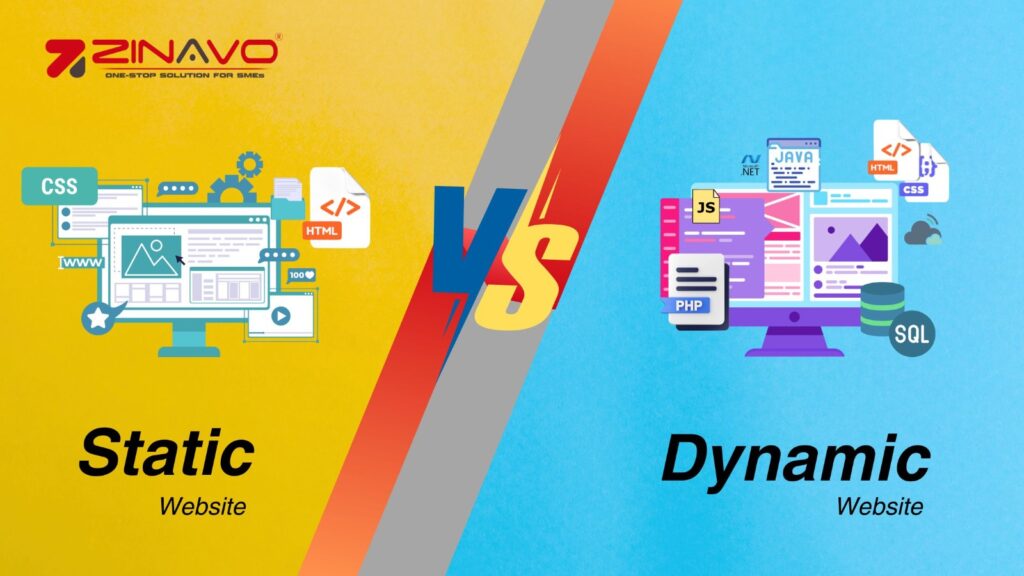Introduction
Creating a business website often leads to confusion for many owners who are faced with the decision between a static and a dynamic website, while website development process. Each option has its own set of advantages, drawbacks, and functionalities.
In simple terms, static websites are fixed and display the same content to all users. They are typically constructed using HTML. In contrast, dynamic websites are more advanced, capable of presenting varied content based on user devices or demographics, providing a more interactive browsing experience. One key distinction is that static websites are quicker to build compared to their dynamic websites.
Now, let’s explore the differences between these two website types, starting with static websites.
What is a static website?
A static website is a common type of website that presents a fixed set of content to all visitors accessing the URL. These websites typically consist of a predetermined number of pages with fixed information that does not change. When viewed on a browser, the content remains static and lacks interactivity with users or their actions. Building a basic static website often involves using HTML and CSS.
Static websites are suitable for businesses that require a smaller online presence, where a few services need to be showcased to customers. The advantage of static websites lies in their quick development time, allowing for a speedy launch within a couple of days. Unlike dynamic websites, where coding adjustments are necessary to alter page layouts, static websites maintain a consistent appearance across all pages.
Despite their static nature, these websites can incorporate interactive elements, such as videos and iFrames, enhancing their visual appeal for visitors. Even though the HTML code remains unchanged regardless of user actions, static websites can still offer an aesthetically pleasing and functional experience.
What is Dynamic website?
Dynamic fluid-design websites incorporate more interactive features, enhancing the overall user experience. These interactive elements facilitate user engagement, contributing to improved page retention times, which is beneficial for SEO. Developing dynamic websites involves a more advanced level of HTML code implementation.
Static websites rely solely on client-side HTML and CSS code, maintaining a fixed presentation for all users. But dynamic websites require both client-side and server-side interactions to respond to users’ requests. Developers utilize server-side scripting languages such as ASP, JavaScript, PHP, among others, to create interactive elements that respond dynamically to user input. When users interact with elements on a dynamic website, the site can dynamically alter its code, performing tasks such as requesting files, playing videos, or fetching data from the server.
Now let’s get technical
When deciding between static and dynamic websites, understanding their technical aspects is crucial. Static websites are constructed using HTML and CSS, requiring no special tools for development or execution. In contrast, dynamic websites necessitate support on both the client and server sides to operate smoothly. In dynamic websites, HTML manages interactive front-end elements, while server-side languages handle response elements.
For those opting to build a dynamic website, numerous elements and functionalities can be integrated to enhance seamlessness and user-friendliness. It’s essential to note that dynamic websites place a heavier load on the server and may require more time to load. To ensure quick loading times, having a faster server is imperative for dynamic websites. In contrast, static websites generally load faster, even if the server is not cloud-based.
Coding differences
Even for beginners in coding, grasping the fundamentals of HTML and CSS makes understanding the construction of a static website accessible. However, achieving optimal results with static websites still requires a higher level of expertise, skills, and domain knowledge. Various tutorials provide overviews of the construction process for those looking to delve into static website development.
Conversely, dynamic websites present a more intricate landscape, demanding careful consideration and attention. To enhance responsiveness, uniqueness, and speed, advanced JavaScript libraries like React might be necessary. The coding for dynamic websites offers limitless possibilities for personalization and functionalities, making it a more extensive and nuanced process compared to static websites.
It’s time to Choose Now!
The decision of which type of website to choose for your business specific needs. If your business thrives on presenting static information to generate leads effectively, then static websites are a suitable choice. Conversely, if you are in an industry like eCommerce or the startup ecosystem, where engaging visitors through dynamic storytelling is essential, dynamic websites make more sense.
Considering the cost aspect, static websites are generally more budget-friendly compared to dynamic counterparts. This cost difference stems from the need for developers to personalize every element in dynamic websites to achieve the desired interaction. Conduct thorough market research to determine the kind of website that aligns with your business goals and helps you capture the majority of leads.
Having an online presence is crucial for staying relevant in today’s hyper-competitive landscape. If you haven’t established a website yet, now is the opportune time to do so. Building your online reputation and increasing brand value are essential steps to thrive in the digital realm.
Conclusion:
In simple we can say, Static websites have fixed content, ideal for simple information display. Dynamic websites, with adaptable content and interactive features, offer enhanced user engagement. Choosing between them depends on the specific needs and goals of a project.
We hope now you are able to choose your website according to your business needs. For more information or queries you are always welcome.



